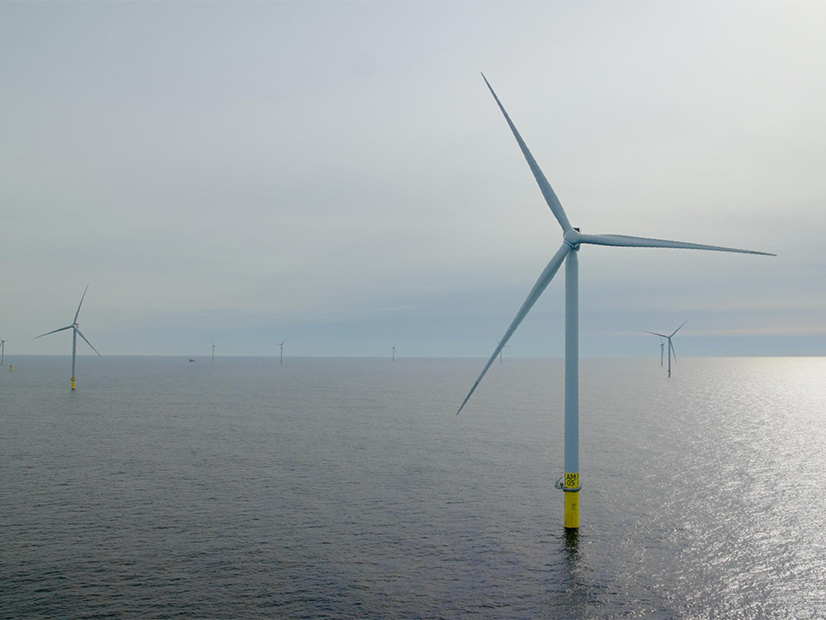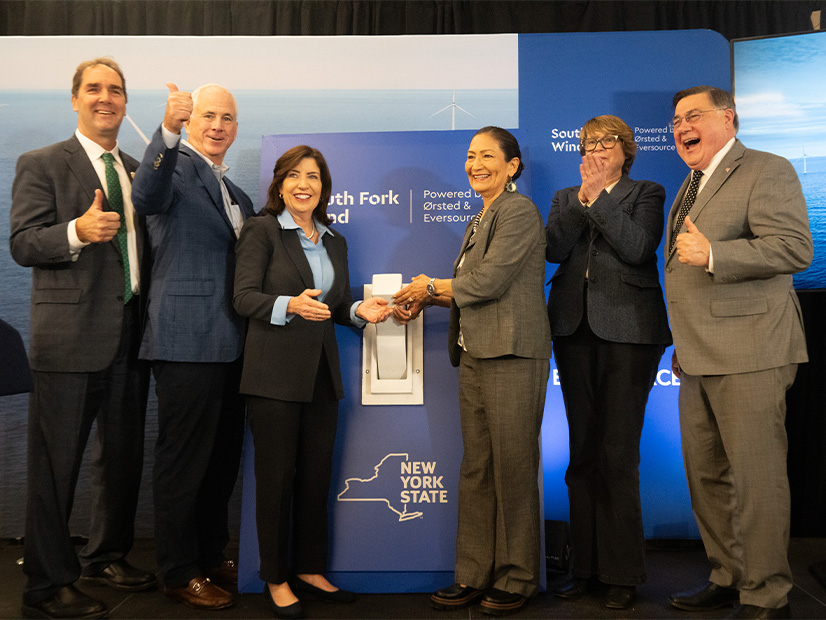
For the first time, a utility-scale wind farm is fully operational in U.S. waters.
All of South Fork Wind’s turbines are sending electricity to the New York power grid. The announcement March 14 is a milestone for the struggling industry which advocates hope will help pave the way for many more.
New York Gov. Kathy Hochul (D) and U.S. Interior Secretary Deb Haaland threw a supersized ceremonial light switch to mark the occasion.
“Today is further proof that America’s clean energy transition is not a dream for a distant future — it’s happening right here and now,” Haaland said.
Hochul said: “With more projects in the pipeline, this is just the beginning of New York’s offshore wind future and I look forward to continued partnership with the Biden administration and local leaders to build a clean and resilient energy grid.”
South Fork’s value is symbolic as much as electrical.
It consists of a dozen turbines and a single offshore substation with a nameplate capacity of only 130 MW and a capacity factor of just 47%.
But it is built, operating and wrapping up its commissioning process.
Developers of the rest of New York’s offshore wind portfolio have canceled their offtake contracts in the past year, and developers canceled multiple projects or contracts north and south of New York, as well.
Soaring construction costs in 2022 and 2023 made previously negotiated contracts with fixed power revenue untenable. First movers South Fork and Vineyard Wind 1 were far enough along in procurement when costs started rising that they could proceed to construction.
The sector is attempting a rebound, albeit at a much higher cost to ratepayers.
In the past few months, New York has tentatively awarded new contracts to two canceled projects and three new projects — the total capacity of all five would be 5,766 MW. (See Sunrise Wind, Empire Wind Tapped for New OSW Contracts.)
New Jersey awarded two contracts totaling 3,742 MW in January. (See NJ Awards Contracts for 3.7 GW of OSW Projects.)
A 6,000-MW joint solicitation by Connecticut, Massachusetts and Rhode Island will close March 27. (See Mass., RI, Conn. Sign Coordination Agreement for OSW Procurement.)
Other bright spots include Revolution Wind, which will be five times larger than South Fork and starts offshore construction later this year; Vineyard Wind 1, which will be six times larger and is under construction; and Coastal Virginia Offshore Wind, which is on schedule for 2026 completion and would be 20 times larger than South Fork.
Each of the states pressing offshore wind development hopes not only to decarbonize its grid but to create a new sector of its economy centered on offshore wind.
The critical mass created by construction and operation of so many gigawatts of wind generation would help make that possible.
Hundreds of Northeastern workers supported South Fork’s construction and hundreds in other regions were involved in assembling the first U.S.-built offshore wind substation.
The turbines were assembled and staged at the State Pier in New London, Conn.; foundation components were completed at Rhode Island’s Provport; helicopters and surface vessels were based in Quonset Point, R.I.; Long Island firms fabricated the concrete mattresses to shield the underwater cables and install the underground cables; and a western New York firm fabricated specialized steelwork.
Trade organizations played up the larger significance of South Fork Wind.
Oceantic Network CEO Liz Burdock said: “The U.S. offshore wind industry now enters a new phase with its first operational commercial-scale wind farm. Now the question is no longer if we can, but how fast we can. A robust collection of U.S. supply chain companies and unions supported development of this project, and the entire U.S. industry should take huge pride in this milestone. The U.S.’s first completed commercial-scale project is providing clean, renewable offshore wind energy to communities and homes.”
New York Offshore Wind Alliance Director Fred Zalcman said: “As we commemorate the completion of the South Fork Wind Farm, the first of many offshore wind farms to provide New York with clean, emissions-free electric power, let us always remember and replicate the formula that got us here. It takes visionary leadership from local, county and state elected officials; strong commitment and community engagement from civic leaders across the labor, business and environmental spectrum; innovative public policy in transitioning to newer and more sustainable forms of electric generation; and the skill, experience and investment capabilities of leading developers to orchestrate the design and construction of these massive infrastructure projects.”
Not everyone cheered the announcement.
Green Oceans President Elizabeth Quattrocki Knight said: “Today’s announcement from Governor Hochul of New York only motivates us to redouble our efforts to protect our oceans and the life they sustain. … Adding a fully activated offshore wind project to the grid will not reduce our reliance on fossil fuels. Instead, the intermittent electricity will cause natural gas plants to operate inefficiently. If we consider the overall carbon footprint of these projects coupled with the environmental harm they will inflict, it is irresponsible to proceed with offshore wind development.”
South Fork Wind is a joint venture between Ørsted and Eversource, which is selling its share to Global Infrastructure Partners.
It was approved in 2017 by the Long Island Power Authority. All other proposed offshore wind projects in the state have been contracted by the New York State Energy Research and Development Authority.



